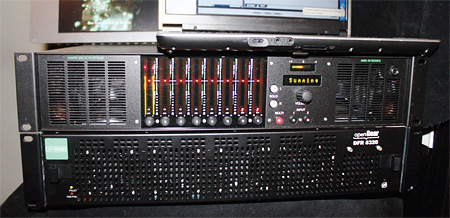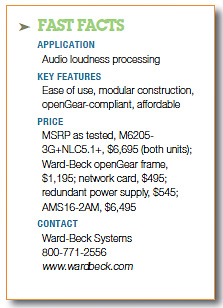Ward-Beck M6205A-3G+NLC Embedded Audio Loudness Processor
With the CALM act moving ahead and compliance for broadcasters now a certainty, stations that have been putting off the installation of dialog normalization-compliant audio processors can no longer do so. Fortunately, the rules and guidelines now in print allow stations to make informed decisions about what equipment they do or do not need.
Ward-Beck, an established broadcast TV and radio equipment manufacturer, has developed a modular 3G/HD/SD-SDI embedded audio processor, their openGear-compliant M6205A-3G/NLC5.1.

The Ward-Beck M6205A-3G+NLC under testFEATURES
This device is a vertically mounted modular card that slides into an openGear 2RU frame. It can extract and process up to 16 channels of embedded audio from a digital video stream and works with SMPTE 292M, 259M, 299M, and 424M, including most widely accepted SD and HD formats at 1080/p60, 1080p/59.94, and 1080p/50.
Two AES inputs allow audio insertion and/or substitution, and the card may also be used as a one-group embedder. Functions include channel shuffling, channel replacement, and mixing. In addition, a SIMM socket has provisions for a single choice of several daughter boards to be added, which can allow the addition of specific processors for DTS and Dolby signals, including Neural Loudness Control, MultiMerge, UpMix, DownMix, Mono2Stereo, Dolby E/AC3 Decoding, or Dolby encoding w/Dolby Prologic II Upmixing. Outputs include four AES audios (after processing), and two SDI outputs which include the processed embedded audio.
For this review, Ward-Beck supplied the M6205A-3G, along with a +NLC5.1 Neural surround loudness processor daughter board for testing and review. To complete the package, they also supplied a DFR 8320 openGear chassis and an AMS16A audio monitor/metering unit, and in case I got bored, they also sent along a +MultiMerge daughter board, to complete the package.
The +NLC5.1 processor measures and controls perceived loudness of the program audio using ITU-R BS.1770/1, as well as DTS-NeuralTM Loudness Measure (NLM) and DTS-Neural Loudness Control (NLC) algorithms. The unit provides processing for both stereo and 5.1 surround content, and according to Ward-Beck, if the processing is used ahead of an AC3 (Dolby Digital) encoder, the target loudness level will be held consistent with the Dialnorm metadata information.
IN USE
For my tests, I provided the gear with a proper, unprocessed, embedded HD signal. I had an extra source of my television station's regular programming stream being delivered as unprocessed 1080i HD, with embedded audio—sometimes in stereo, sometimes in 5.1.
I ran the embedded (unprocessed) A/V signal through a Blackmagic Design monitor for confidence viewing, and connected a feed to the input of the M6205A-3G card (housed in the DFR 8320 frame), following the supplied Ward-Beck diagram. Next, I connected the output of the card to the AMS16A for audio level/sound monitoring. The AMS16A allows metering and sound monitoring of individual channels, or it can do a down-mix, either of which is easily selected with the press of a button. When I powered up all of the units, lights appeared on the openGear chassis, I saw a picture on the 8-inch monitor, and about five seconds later, sound was pouring from the audio monitor.
This was all well and good, but I needed to know what equipment was functioning, and how. I connected my old Gateway laptop and opened up the Dashboard control application that I keep on that machine. The folks at Ward-Beck had provided me with an IP quick-start guide that explained how to connect to their frame using either a fixed IP address or dynamic host configuration protocol. For simplicity, I connected my laptop to the DFR 8320 openGear frame using a crossover Cat-5 cable, and set the two DIP switches on the MFC-8320-N network card for direct connection at 192.168.2.1 (255.255.0.0). After a bit of network tweaking on my PC, I refreshed the menu tree on Dashboard. In a few seconds, the screen recognized slots 0, 2, and 4 as home to the 8320-N, M6205a-3G+MM, and 6205a-3G+NLC cards, respectively.
When I clicked on the 8320-N icon, several tabs came on screen, including: Setup (for SNMP info, fan status, and slot naming), Network (frame name, and IP info), Data Safe, and SNMP (for SNMP management). Also on present on the screen were tabs for product information, hardware status, power management and measurement.
When I selected the 6250A-3G+NLC icon, two sections of tabs appeared. The first section included card info, card status, and DTS information (serial number and revision numbers for both hardware and firmware). The second tab section provided the main operation tabs. The main card tab—Audio Embedder—allowed group and channel management, along with custom setups. The daughter board (+NLC) had two tabs, including NLC Settings and NLC Presets. Under settings, there were areas to select/shuffle audio channels, and an obvious button to select the processor for "In Line" or "Bypass." There's also a simple "Target Level Slider" with a selector point that you can drag with a mouse from ‚àí40 to ‚àí1 dB. There's a dialog box to the right of the slider for direct level entry.
Our facility uses ‚àí23 as the Dialnorm number, so that was the value I entered into the box.

The final tab was NLC Preset. Here, you can choose from several presets: Light, Medium, Aggressive, or User. I'm not really big on processing, so I left the unit in the Light mode. Below that setting there were selections for upper and lower thresholds, noise floor (set at ‚àí50), attack and release times (50 ms and 220 ms respectively), and "dead band." Unlike many processors I've seen, this one appeared to be simple and straightforward.
In our plant, we have basically four audio sources: NBC, local commercial playout, local syndication playout (which is embedded and can be any combination of stereo, C—L+R, or 5.1), and local news production, which originates as non-embedded stereo. Such a combination makes for level differences, no matter how much time and effort is expended in trying to keep things on an even keel. If it weren't for some sort of audio processor, life could be rather problematic.
With everything hooked up, and a good basic understanding of the tools in front of me, I started monitoring the audio output of the 6205A-3G+NLC. I could immediately spot a difference when I bypassed the unit. Content would vary, and levels would rise and fall, depending on how they were produced. When I took it out of bypass mode, the levels did indeed seem to stay more in line with normal listening. I ran levels up and down, and played with the attack/release times. I even adjusted the noise floor reference level. I kept the unit hooked up for more than a month, and every time I adjusted on it, I ended up putting the settings back where they were when it arrived. (Again, I prefer "light" processing—just enough to take the edge off.)
SUMMARY
During my extensive test period, the units submitted for evaluation never once blinked or stuttered. The Ward-Beck workmanship is outstanding, and operation was simple. I did find that the daughter boards tend to stick out from the main card a bit, so card insertion/removal could be a bit tricky. I'd also like to state that the operator's manual is a perfect blend of engineering and operational information.
Joey Gill is chief engineer at WPSD-TV in Paducah, Ky. and has been with the station for 30 years. He has worked in television since 1977. He may be contacted at respond2jgill@yahoo.com.
Get the TV Tech Newsletter
The professional video industry's #1 source for news, trends and product and tech information. Sign up below.
